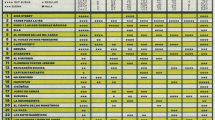Abstract
A soft matrix multiplication of matrices in different types was not possible so far. In this study, we generalize the soft matrix products And, And–Not, Or, Or–Not defined in Çağman and Enginoğlu (Comput Math Appl 59:3308–3314, 2010) so as to multiply soft matrices in different types. Furthermore, these generalizations allow us to multiply soft matrices more than two soft matrices. Therefore, we can solve decision making problems with multiple decision makers using a single product. These new operations make the process of solving decision making problems faster, easier and more convenient. Then we construct some effective decision making methods called soft distributive max–min (max–max, min–min, min–max) decision making methods. We also provided Scilab codes to demonstrate our methods.
Similar content being viewed by others
References
Acar U, Koyuncu F, Tanay B (2010) Soft sets and soft rings. Comput Math Appl 59:3458–3463
Aktaş H, Çağman N (2007) Soft sets and soft groups. Inf Sci 177:2726–2735
Aktaş H, Çağman N (2009) Erratum to “Soft sets and soft groups”. Inf Sci 179:338
Ali MI, Feng F, Liu X, Min WK, Shabir M (2009) On some new operations in soft set theory. Comput Math Appl 57:1547–1553
Atagün AO, Sezgin A (2011) Soft substructures of rings, fields and modules. Comput Math Appl 61:592–601
Chen D, Tsang ECC, Yeung DS (2003) Some notes on the parameterization reduction of soft sets. Int Conf Mach Learn Cyber 3:1442–1445
Chen D, Tsang ECC, Yeung DS, Wang X (2005) The parametrization reduction of soft sets and its applications. Comput Math Appl 49:757–763
Çağman N, Çıtak F, Aktaş H (2012) Soft int-group and its applications to group theory. Neural Comput Appl 21:151–158
Çağman N, Enginoğlu S (2010) Soft matrix theory and its decision making. Comput Math Appl 59:3308–3314
Çağman N, Enginoğlu S (2010) Soft set theory and uni-int decision making. Eur J Oper Res 207:848–855
Feng F, Jun YB, Zhao X (2008) Soft semirings. Comput Math Appl 56:2621–2628
Feng F, Li Y, Çağman N (2012) Generalized uni-int decision making schemes based on choice value soft sets. Eur J Oper Res 220:162–170
Feng F, Fujita H, Jun YB, Khan M (2014) Decomposition of fuzzy soft sets with finite value spaces. Sci World J, Article ID 902687, p 10
Feng Q, Zhou Y (2014) Soft discernibility matrix and its applications in decision making. Appl Soft Comput 24:749–756
Gau WL, Buehrer DJ (1993) Vague sets. IEEE Trans Syst Man Cybern 23:610–614
Gong K, Xiao Z, Zhang X (2010) The bijective soft set with its operations. Comput Math Appl 60:2270–2278
Gorzalzany MB (1987) A method of inference in approximate reasoning based on interval-valued fuzzy sets. Fuzzy Set Syst 21:1–17
Herawan T (2010) Soft set-based decision making for patients suspected influenza-like illness. Int J Mod Phys Conf Ser 1:1–5
Herawan T, Deris MM (2009) A direct proof of every rough set is a soft set. In: Third Asia international conference on modelling and simulation, Bandung, Bali, Indonesia, pp 119–124
Herawan T, Deris MM (2010) Soft decision making for patients suspected influenza. In Taniar D et al (eds) ICCSA 2010, Part III, lecture notes in computer science, Springer 6018:405–418
Jun YB, Park CH (2008) Applications of soft sets in ideal theory of BCK/BCI-algebras. Inf Sci 178:2466–2475
Kong Z, Gao L, Wang L, Li S (2008) The normal parameter reduction of soft sets and its algorithm. Comput Math Appl 56:3029–3037
Maji PK, Biswas R, Roy AR (2003) Soft set theory. Comput Math Appl 45:555–562
Maji PK, Roy AR, Biswas R (2002) An application of soft sets in a decision making problem. Comput Math Appl 44:1077–1083
Molodtsov D (1999) Soft set theory-first results. Comput Math Appl 37:19–31
Mushrif MM, Sengupta S, Ray AK (2006) Texture classification using a novel, soft-set theory based classification, algorithm. Lect Notes Comput Sci 3851:246–254
Pawlak Z (1982) Rough sets. Int J Inf Comput Sci 11:341–356
Pawlak Z (1997) Rough set approach to knowledge-based decision support.Soft sets and soft rings. Eur J Oper Res 99:48–57
Pawlak Z, Skowron A (2007) Rudiments of rough sets. Inf Sci 177:3–27
Pei D, Miao D (2005) From sets to information systems. In: Hu X, Liu Q, Skowron A, Lin TY, Yager RR, Zhang B (eds) IEEE proceedings of granular computing vol 2, pp 617–621
Roy AR, Maji PK (2007) A fuzzy soft set theoretic approach to decision making problems. J Comput Appl Math 203:412–418
Sezer AS (2012) A new wiev to ring theory via soft union rings, ideals and bi-ideals. Knowl Based Syst 36:300–314
Sezgin A, Atagün AO (2011) On operations of soft sets. Comput Math Appl 61:1457–1467
Xiao Z, Chen L, Zhong B, Ye S (2005) Recognition for soft information based on the theory of soft sets. In: Chen J (ed) IEEE proceedings of ICSSSM-05 vol 2, pp 1104–1106
Xiao Z, Gong K, Xia S, Zou Y (2010) Exclusive disjunctive soft sets. Comput Math Appl 59:2128–2137
Yang X, Yu D, Yang J, Wu C (2007) Generalization of soft set theory: from crisp to fuzzy case. In: Cao B-Y (ed) Fuzzy information and engineering: proceedings of ICFIE 2007, Advances in soft computing, vol 40, Springer, pp 345–355
Zadeh LA (1965) Fuzzy sets. Inf Control 8:338–353
Zadeh LA (2005) Toward a generalized theory of uncertainty (GTU)—an outline. Inf Sci 172:1–40
Author information
Authors and Affiliations
Corresponding author
Ethics declarations
Conflict of interest
The authors declare that there is no conflict of interests regarding the publication of this paper.
Appendix
Appendix
Scilab Algorithms: We give following algorithms since one of the generalized products which \(\curlyvee \), \(\overset{-}{\curlywedge }\) and \(\underset{-}{\curlyvee }\) we can use for decision problems.

We give following algorithms since one of the decision making methods (SDmMDM), (SDmmDM) and (SDMMDM) we can use for decision problems.

Rights and permissions
About this article
Cite this article
Atagün, A.O., Kamacı, H. & Oktay, O. Reduced soft matrices and generalized products with applications in decision making. Neural Comput & Applic 29, 445–456 (2018). https://doi.org/10.1007/s00521-016-2542-y
Received:
Accepted:
Published:
Issue Date:
DOI: https://doi.org/10.1007/s00521-016-2542-y




